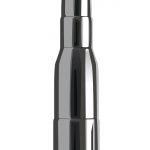Our last blog post about silver bullets talked about the history behind the bullets’ reputation for effectiveness. In this post, we’ll talk about the properties of silver vs. lead when it comes to refining them into bullets.
Density is one of the most important factors in bullet design. An object’s energy is directly related to its mass (remember, E = mc2). To put it simply, heavy bullets work better than light bullets. This principle is one of the reasons why lead (renowned for its density) is used to make bullets. Silver is less dense than lead, but not irredeemably so. Silver is roughly 7.5% less dense than lead – so it can still make an effective bullet in that regard.
But that doesn’t mean silver bullets are just as easy to make. In order to refine the metal into bullets, it must be melted first. Here, silver presents a two-fold problem. Lead melts at 621.43 °F, which in refinery terms is rather cool – ordinary fire can do the trick. Silver, however, has a melting point almost three times higher than lead at 1763.2 °F. Additionally, the bullet mold needs to be heated to nearly the same temperature of the metal being poured into it. A mold that is too cold will crack or produce malformed bullets. It’s doubtful that Jean Chastel or The Lone Ranger had ready access to that kind heat.
In our next post, we’ll wrap up our discussion of metal properties and find out whether silver bullets can have any ballistic effectiveness.










